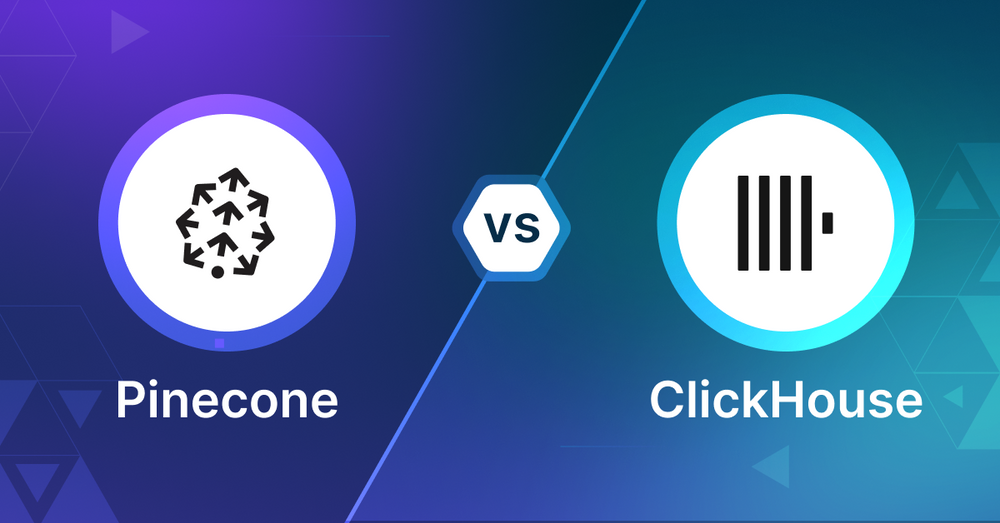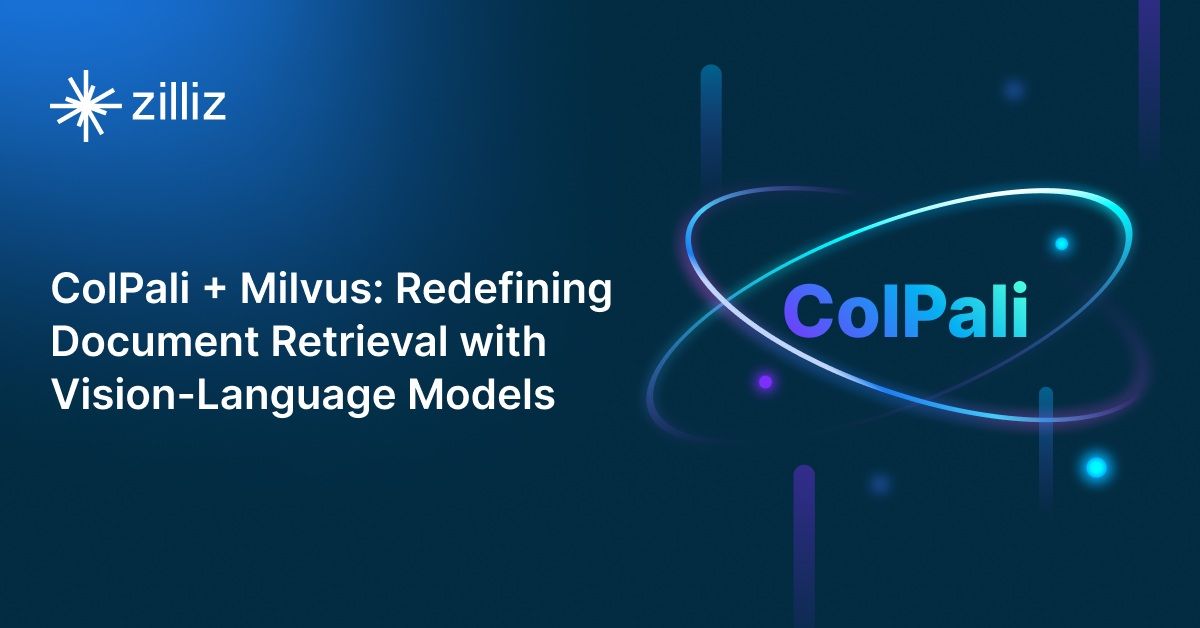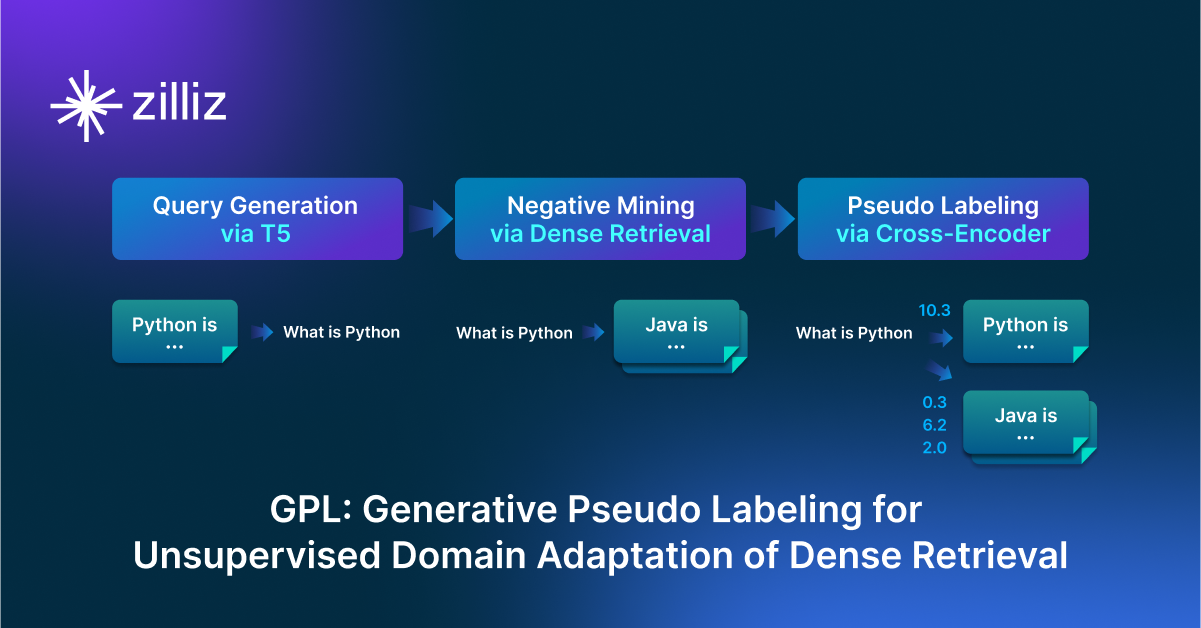Pinecone vs ClickHouse: Selecting the Right Database for GenAI Applications

As AI-driven applications evolve, the importance of vector search capabilities in supporting these advancements cannot be overstated. This blog post will discuss two prominent databases with vector search capabilities: Pinecone and ClickHouse. Each provides robust capabilities for handling vector search, an essential feature for applications such as recommendation engines, image retrieval, and semantic search. Our goal is to provide developers and engineers with a clear comparison, aiding in the decision of which database best aligns with their specific requirements.
What is a Vector Database?
Before we compare Pinecone vs ClickHouse, let's first explore the concept of vector databases.
A vector database is specifically designed to store and query high-dimensional vectors, which are numerical representations of unstructured data. These vectors encode complex information, such as the semantic meaning of text, the visual features of images, or product attributes. By enabling efficient similarity searches, vector databases play a pivotal role in AI applications, allowing for more advanced data analysis and retrieval.
Common use cases for vector databases include e-commerce product recommendations, content discovery platforms, anomaly detection in cybersecurity, medical image analysis, and natural language processing (NLP) tasks. They also play a crucial role in Retrieval Augmented Generation (RAG), a technique that enhances the performance of large language models (LLMs) by providing external knowledge to reduce issues like AI hallucinations.
There are many types of vector databases available in the market, including:
- Purpose-built vector databases such as Milvus, Zilliz Cloud (fully managed Milvus)
- Vector search libraries such as Faiss and Annoy.
- Lightweight vector databases such as Chroma and Milvus Lite.
- Traditional databases with vector search add-ons capable of performing small-scale vector searches.
Pinecone is a purpose-built vector database and ClickHouse is an open-source column-oriented database with vector search capabilities as an add-on. This post compares their vector search capabilities.
Pinecone: The Basics
Pinecone is a SaaS built for vector search in machine learning applications. As a managed service, Pinecone handles the infrastructure so you can focus on building applications not databases. It’s a scalable platform for storing and querying large amounts of vector embeddings for tasks like semantic search and recommendation systems.
Key features of Pinecone include real-time updates, machine learning model compatibility and a proprietary indexing technique that makes vector search fast even with billions of vectors. Namespaces allow you to divide records within an index for faster queries and multitenancy. Pinecone also supports metadata filtering, so you can add context to each record and filter search results for speed and relevance.
Pinecone’s serverless offering makes database management easy and includes efficient data ingestion methods. One of the features is the ability to import data from object storage, which is very cost effective for large scale data ingestion. This uses an asynchronous long running operation to import and index data stored as Parquet files.
To improve search Pinecone hosts the multilanguage-e5-large model for vector generation and has a two stage retrieval process with reranking using the bge-reranker-v2-m3 model. Pinecone also supports hybrid search which combines dense and sparse vector embeddings to balance semantic understanding with keyword matching. With integration into popular machine learning frameworks, multiple language support and auto scaling Pinecone is a complete solution for vector search in AI applications with both performance and ease of use.
ClickHouse: Overview and Core
ClickHouse is an open-source OLAP database for real-time analytics with full SQL support and fast query processing. It’s great for analytical queries because of fully parallelized query pipeline and can do vector search fast. It has high compression (customizable through codecs) so can store and query big datasets. One of its main advantages is that it can handle multi-TB datasets without being memory bound so it’s a great tool for users with large vector data. Also supports filtering and aggregation on metadata, so you can query vectors and their metadata.
ClickHouse has vector search functionality through SQL where vector distance operations are just like any other SQL function. So you can combine it with traditional filtering and aggregation. Great for use cases where you need to query vector data along with metadata or other information. Also has experimental Approximate Nearest Neighbour (ANN) indices for faster (but approximate) matching. And exact matching through linear scan over rows with parallel processing for speed and efficiency.
ClickHouse is great for vector search when you need to combine vector matching with metadata filtering or aggregation. Especially for very large vector datasets that need to be processed in parallel across multiple CPU cores. ClickHouse is also good when you need SQL support and your vector dataset is too big to fit in memory-only indices. Also if you already have related data in ClickHouse or don’t want to learn another tool to manage millions of vectors, ClickHouse can save you time and resources. Fast parallelized exact matching and handling big datasets is what ClickHouse is good for, so it’s for advanced search users.
ClickHouse is a general purpose platform for vector search, especially for large datasets that need parallel processing and when you combine vector search with SQL-based filtering and aggregation. Not as good as specialized vector databases for small memory-bound datasets or high-QPS scenarios but can handle complex queries including metadata so great for developers who know SQL and need fast vector search.
Key Differences
When choosing a vector search tool, understanding the differences between Pinecone and ClickHouse will help you make an informed decision. Both are good for different use cases in vector search.
Search Method
Pinecone uses a proprietary indexing technique for vector search, so it’s super fast for similarity search across billions of vectors. It supports real-time updates and has a 2 stage retrieval with reranking.
ClickHouse was designed for OLAP workloads, it approaches vector search through SQL. It does exact matching through linear scans with parallel processing and has experimental ANNs for faster, approximate matching.
Data
Pinecone is designed for storing and querying vector embeddings. It supports metadata filtering so you can add context to each record and refine search results.
ClickHouse is great for structured and semi-structured data. Its SQL foundation makes it powerful for combining vector search with traditional data operations like filtering and aggregation.
Scalability and Performance
Pinecone has auto-scaling and is designed for billions of vectors. Its serverless architecture helps with performance at scale while keeping control of costs.
ClickHouse is great with large datasets, it uses parallel processing across multiple CPU cores. It can handle multi-TB datasets without being memory bound, so it’s good for users with lots of vector data.
Flexibility and Customization
Pinecone has namespaces to divide records within an index, to speed up queries and support multitenancy. It also has hybrid search, dense and sparse vector embeddings.
ClickHouse has a SQL interface so you can write highly custom queries, combine vector operations with complex data manipulation. Its compression options (through codecs) gives you flexibility in data storage.
Integration and Ecosystem
Pinecone integrates with popular ML frameworks and supports multiple languages. It also hosts models for vector generation and reranking.
ClickHouse being a general purpose OLAP database integrates well with many data processing and visualization tools. Its SQL interface is familiar to users of relational databases.
Ease of Use
Pinecone, as a managed service, handles infrastructure for you, so you can focus on building your LLM application, not the database. Its serverless offering makes database management even simpler.
ClickHouse requires more setup and maintenance but is familiar to those with SQL knowledge. Its documentation is good but the learning curve is steeper if you’re new to OLAP systems.
Cost
Pinecone is priced by the number of vectors stored and reads and writes. Its serverless option is cost effective for variable workloads.
ClickHouse, being open source, can be self hosted, which can reduce costs for organizations with existing infrastructure. But that comes with management overhead.
Security
Pinecone has standard security features of a managed service, encryption and access controls.
ClickHouse has many security features, encryption, authentication, fine grained access control which can be customized to your security requirements.
When to Use Each
Pinecone is good for applications that need dedicated vector search, especially in machine learning and GenAI driven use cases. It’s great for large scale similarity searches, recommendation systems and semantic search use cases. Pinecone is perfect when you need real time updates, handling billions of vectors and a managed service, so you can focus on application development, not infrastructure management. Choose Pinecone when your main focus is on vector operations, you need seamless scalability and you want a solution that integrates with machine learning workflows.
ClickHouse is for when you need to combine vector search with complex analytics on large datasets. It’s great for situations where vector search is part of a larger data analytics workflow, especially when dealing with large datasets that need parallel processing. ClickHouse is perfect when you need to search vectors alongside traditional SQL, metadata filtering and aggregations. Choose ClickHouse when you have a team that’s comfortable with SQL, need flexibility in data modeling and querying and want to use vector search within an OLAP database.
Conclusion
Pinecone is for dedicated vector search with minimal management overhead. ClickHouse is for vector search as part of a larger analytical workflow. Your choice between the two should be based on your use case, data types and performance requirements. Consider the scale of your vector data, complexity of your queries, your team and your existing infrastructure. Pinecone is best for dedicated vector search needs. ClickHouse is better for vector search in a broader analytical workflow. Ultimately it’s about aligning the technology with your project’s requirements and long term scalability needs.
Read this to get an overview of Pinecone and ClickHouse but to evaluate these you need to evaluate based on your use case. One tool that can help with that is VectorDBBench, an open-source benchmarking tool for vector database comparison. In the end, thorough benchmarking with your own datasets and query patterns will be key to making a decision between these two powerful but different approaches to vector search in distributed database systems.
Using Open-source VectorDBBench to Evaluate and Compare Vector Databases on Your Own
VectorDBBench is an open-source benchmarking tool for users who need high-performance data storage and retrieval systems, especially vector databases. This tool allows users to test and compare different vector database systems like Milvus and Zilliz Cloud (the managed Milvus) using their own datasets and find the one that fits their use cases. With VectorDBBench, users can make decisions based on actual vector database performance rather than marketing claims or hearsay.
VectorDBBench is written in Python and licensed under the MIT open-source license, meaning anyone can freely use, modify, and distribute it. The tool is actively maintained by a community of developers committed to improving its features and performance.
Download VectorDBBench from its GitHub repository to reproduce our benchmark results or obtain performance results on your own datasets.
Take a quick look at the performance of mainstream vector databases on the VectorDBBench Leaderboard.
Read the following blogs to learn more about vector database evaluation.
Further Resources about VectorDB, GenAI, and ML
- What is a Vector Database?
- Pinecone: The Basics
- ClickHouse: Overview and Core
- Key Differences
- When to Use Each
- Conclusion
- Using Open-source VectorDBBench to Evaluate and Compare Vector Databases on Your Own
- Further Resources about VectorDB, GenAI, and ML
Content
Start Free, Scale Easily
Try the fully-managed vector database built for your GenAI applications.
Try Zilliz Cloud for FreeKeep Reading
Milvus/Zilliz + Surveillance: How Vector Databases Transform Multi-Camera Tracking
See how Milvus vector database enhances multi-camera tracking with similarity-based matching for better surveillance in retail, warehouses and transport hubs.

ColPali + Milvus: Redefining Document Retrieval with Vision-Language Models
When combined with Milvus's powerful vector search capabilities, ColPali becomes a practical solution for real-world document retrieval challenges.

GPL: Generative Pseudo Labeling for Unsupervised Domain Adaptation of Dense Retrieval
GPL is an unsupervised domain adaptation technique for dense retrieval models that combines a query generator with pseudo-labeling.
The Definitive Guide to Choosing a Vector Database
Overwhelmed by all the options? Learn key features to look for & how to evaluate with your own data. Choose with confidence.